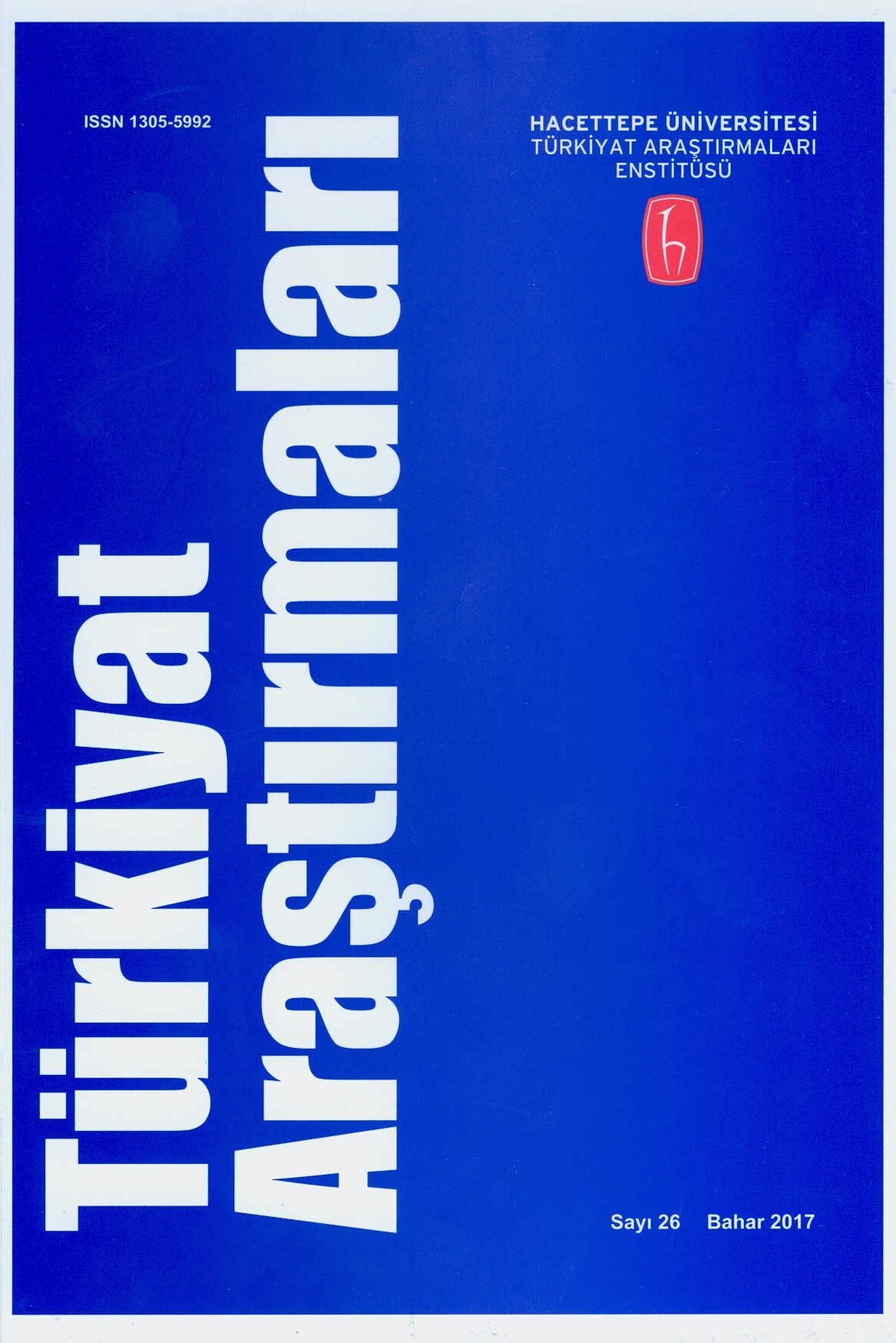BÂKÎ’NİN “SÜNBÜL KASİDESİ”Nİ YÖNELİM METAFORLARI ÜZERİNDEN OKUMAK
Çağdaş metafor teorisinin kurucuları George Lakoff ve Mark Johnson, metafor kavramını bilişsel düzeyde ele almış ve bu kavramı yapı metaforları, yönelim metaforları ve ontolojik metaforlar olmak üzere üç kısma ayırmıştır. Yönelim metaforları; yukarı-aşağı, içeri-dışarı, ön-arka, merkez-çevre gibi uzay/mekân istikametleriyle ilişkili metaforlardır. Bu tür metaforlarda kavramlar, sözü edilen istikametlere göre organize edilmiştir. Bu çalışmada Bâkî’nin, hocası Karamanlı Mehmet Efendi için yazdığı “sünbül” redifli kasidesi, yönelim metaforları açısından ele alınmıştır. Kasidenin nesip bölümünde iki, methiye bölümünde on ve tegazzül bölümünde iki beyitte yönelim metaforları tespit edilmiştir. Bu beyitlerde aşağı-yukarı, iç-dış, merkez-çevre istikametleri kullanılmıştır. Kasidenin nesip bölümünde sümbül, yukarıda konumlandırılarak diğer çiçeklerden güzellik yönünden üstün tutulmuştur. Sümbül sembolü üzerinden öğrenci-hoca hiyerarşisi yansıtılan methiye bölümünde, Karamanlı Mehmet Efendi yukarı, iç ve merkezde konumlandırılarak yüceltilmiştir. Yönelim metaforlarından en yoğun olarak yararlanılan methiye bölümünde memduhun çoğunlukla manevi güzellikleri övülmüştür. Övgünün devam ettiği tegazzülde ise Karamanlı Mehmet Efendi’nin saçı ve yanağı, yönelim metaforlarından yararlanılarak yukarıda konumlandırılarak güzellik yönünden yüceltilmiştir. Kasidenin fahriye ve dua bölümünde ise yönelim metaforları kullanılmamıştır.
Anahtar kelimeler: Divan edebiyatı, Bâkî, Sünbül Kasidesi, çağdaş metafor teorisi, yönelim metaforları.
Anahtar Kelimeler:
Divan edebiyatı, Bâkî, Sünbül Kasidesi, çağdaş metafor teorisi, yönelim metaforları.
Reading Bâkî’s “Sunbul Qasida” Through Orientational Metaphors
The creators of the contemporary theory of metaphor, George Lakoff and Mark Johnson, discussed the concept of metaphor as a cognitive element and classified this concept into three parts as structural, orientational, and ontological metaphor. Orientational metaphors are related to spatial directions such as up-down, in-out, front-back, and center-periphery. Concepts in that kind of metaphors are organized in terms of these directions. In this study, Bâkî's qasida with “sünbül (hyacinth)” redif (repeated word), which he wrote for his mentor Karamanlı Mehmet Efendi, is examined in terms of orientational metaphors. Orientational metaphors are detected in two couplets in the nesip (introduction) part of the qasida, ten in the praise section, and two in the tegazzül (gazel in qasida) section. In these couplets, up-down, inside-out, and center-periphery directions are used. In the nesip (introduction) part of the qasida, the hyacinth is positioned above and is superior to other flowers in terms of beauty. In the praise section, which reflects the student-teacher hierarchy through the hyacinth symbol, Karamanlı Mehmet Efendi is exalted by positioning him in the upper, inner, and center. In the praise section, in which orientational metaphors are most frequently used, the spiritual beauties of the Karamanlı Mehmet Efendi were praised. In the 'tegazzül' section where the praise continues, Karamanlı Mehmet Efendi's hair and cheeks are exalted in terms of beauty by positioning them above through the orientation metaphors. Orientational metaphors are not used in the self-praise and blessing sections of the qasida.
Keywords:
Divan literature, Bâkî, Sunbul Qasida, the contemporary theory of metaphor, orientational metaphors.,
___
- Bilgegil, M. K. (2015). Edebiyat Bilgi ve Teorileri. Erzurum: Salkımsöğüt Yay.
- Çavuşoğlu, M. (1986). Kasîde. Türk Dili: Dil ve Edebiyat Dergisi Türk Şiiri -Divan Şiiri-, 415-416-417, 17-77.
- Demirel, Ş. (2005). Tâhirü’l-Mevlevî (Olgun)’den Metin Şerhi Örnekleri. Ankara: Araştırma Yay.
- Küçük, S. (2019). Bâkî Dîvânı. Ankara: TDK Yay.
- Lakoff, G. (1992). The Contemporary Theory of Metaphor. 01.11.2022 tarihinde https://georgelakoff.files.wordpress.com/2011/04/the-contemporary-theory-of-metaphor-in-ortony-andrew-ed-metaphor-and-thought-lakoff-1992.pdf adresinden erişildi.
- Lakoff, G. ve Johnson, M. (2015). Metaforlar: Hayat, Anlam ve Dil (G. Yavuz Demir, Çev.). İstanbul: İthaki Yay.
- Núñez, R. E. ve Sweetser, E. (2006). With the Future Behind Them: Convergent Evidence From Aymara Language and Gesture in the Crosslinguistic Comparison of Spatial Construals of Time. Cognitive Science, 30(3), 401-450.
- Şahin, E. (2018). Bâkî’nin “Sünbül” Kasidesi Şerhi. Hikmet - Akademik Edebiyat Dergisi Prof. Dr. Ali Nihad Tarlan Özel Sayısı, 415-450.
- Topaloğlu, B. (1993). Cennet. İslâm Ansiklopedisi içinde (C. 7, ss. 376-386). İstanbul: TDV Yay.
- ISSN: 1305-5992
- Yayın Aralığı: Yılda 2 Sayı
- Başlangıç: 2004
- Yayıncı: Hacettepe Üniversitesi
Sayıdaki Diğer Makaleler
TÜRKÇE DERS KİTAPLARINDA YER ALAN ANLATISAL METİNLERDE OKUR EMPATİSİNİ YÖNLENDİREN DİLSEL GÖRÜNÜMLER
YÛNUS EMRE DÎVÂNINDA SUR UR- YAPISI ÜZERİNE
BULANIK-GÖSTERGEBİLİM IŞIĞINDA YÂD-I MÂZİ’DE BİÇEM VE ANLAM
DİL İLİŞKİLERİNDE KULLANIM TEMELLİ YAKLAŞIM
DOĞAL OLMAYAN ANLATI VE ABDÜLHAK HÂMİD’İN TİYATROLARI
BÂKÎ’NİN “SÜNBÜL KASİDESİ”Nİ YÖNELİM METAFORLARI ÜZERİNDEN OKUMAK
SÖZDİZİMİ KURAMINDA KURUCULAR AÇISINDAN CÜMLE YAPISI
AHMED PAŞA’NIN “GÜNEŞ” REDİFLİ KASİDESİNDE GÜNEŞ-HÜKÜMDAR SEMBOLÜNÜN MİTOLOJİK YÖNLERİ
